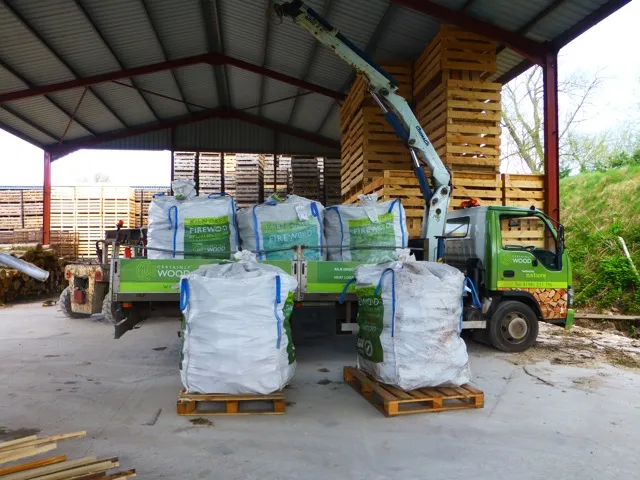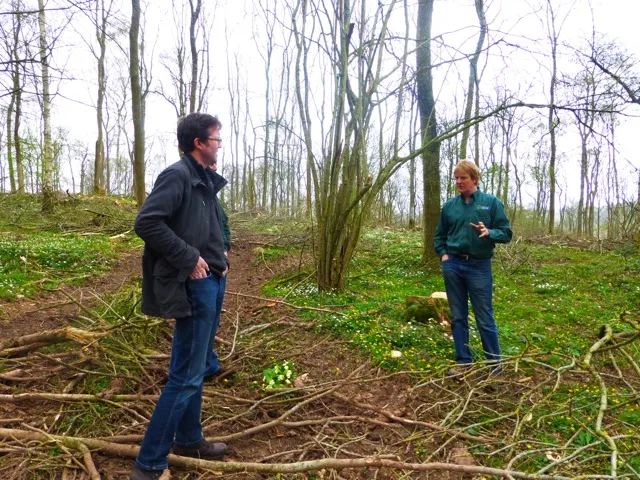April departed with two weeks of dry and bright weather and May began with sublime sunshine and actual warmth. Thank God. I’m down to just three layers. The glorious weather put a spring in everyone’s step – people were smiling in the lift at work, butterflies have appeared in the garden and from my home office window I can see a couple of fields beginning to glow yellow as oilseed rape comes into flower. Amazing – those fields were covered in snow five weeks ago.
Yet I’ve managed to find two brothers who are almost sorry to see the back of the long hard winter. They are Nic and George Snell – and they’re in the firewood trade. So cold and bleak means more orders.
But they claim to have revolutionised the firewood market – they’re Britain’s biggest producers of kiln-dried wood – some 16,000 tonnes a year.
The idea is relatively simple. In order to burn effectively and produce maximum heat, firewood needs to be seasoned – left to dry out so that it’s moisture content is no more than about 20%. But this takes time and varies between tree species. Ash, for example, might only take 6-9 months to season, while denser oak or beech can take 2 years. When you buy a boot or trailer full of firewood, say the Snells, you never know what you’re getting and just how seasoned it is. Kiln-dried wood seasons it instantly, to a basic standard whatever the species.

Intrigued, I visited their operation just over the border into deeply rural Herefordshire. Used to small-scale woodland enterprises, I was gobsmacked to see the entire farm yard had been turned over to firewood production – although George also runs a productive soft-fruit farm nearby too. Essentially, they buy in wood from all over the country – when I was there, there were received the first delivery of several thousand tones of beech from Savernake Forest in Wiltshire.
The wood is cut up and split on site – I drooled with envy at the machinery that could turn a 2ft diameter tree into neat logs in seconds. The cut wood goes into cages that are then stacked into converted containers. These are the kilns. I wondered at where the power to heat the kilns came from and wouldn't this rather diminish the green. sustainable credentials of the kiln dried wood? But then George showed me the wood chip boiler that provided the heat, powered largely by the waste wood, sawdust and twigs from the sawmill.
George stressed to me the importance of sustainability – wood are never clear felled but managed to produce firewood for now and for future generations. To this end, he took me to one of the most enchanting ash woods I’ve ever explored, somewhere lost in the heart of Herefordshire. Even George got lost in the back lanes trying to find it.

Contractors had been in recently to thin the trees, leaving glades and light among the handsome remainder. These too would be thinned again in a few years, while saplings rose up to replace those cut down during the previous cycle. The woodland floor was ablaze with primroses and wood anemones, while cuckoo-flowers flourished in damper corners. It was astonishing, and an example of how all our woods should be.
Nic kindly gave me a bag of the kiln-dried logs to test out at home. I did a comparison with some ‘seasoned’ logs from my own woodshed. Using kiln-dried logs, it took just 10 minutes to reach the optimum 500°F in the wood-burning stove, while it took over 30 minutes with the conventional logs. So these guys are on to something…
Before I left, George said to me: “you know, we don’t really rub our hands with glee if winter is long and cold. We need the sun and warmth just as much as everyone else – to grow us trees for future harvests. And it helps with the log drying, too.” And with that he turned back to admire his firewood farm with all of its marvellous contraptions.
Note: as I post this on the website, it’s 15 May and 6°C outside during the day. Another log on the bl***dy fire.

